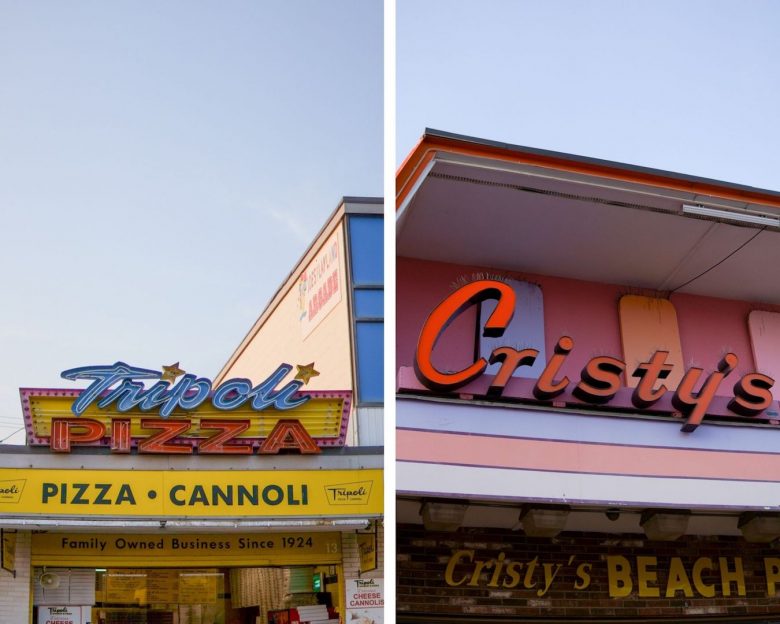Guide to New England Pizza Styles
Do you know the difference between Salisbury beach pizza and Rhode Island pizza strips? Become a local pie expert in our guide to New England pizza styles.

Coffee By Design | Portland, Maine
Photo Credit : Katherine KeenanPizza isn’t the first thing that comes to mind when most people think of New England. From lobster rolls to Boston cream pie, the region has an array of iconic foods that often steal the limelight (and with good reason). Still, as many New Englanders will attest, our pizza deserves its moment in the sun. Along with piping-hot bowls of chowder and top-split hot dog buns, New England also boasts a number of distinctive and delicious pizza styles.
There are the big chains with humble New England beginnings — Papa Gino’s, Bertucci’s, Flatbread Pizza Company, etc. Then there are the Greek-style pies, which are represented throughout New England at Greek restaurants and family joints with names like Pizza Factory and House of Pizza. Finally, there are the strictly local styles, with the most prominent being New Haven “apizza,” South Shore bar pizza, Salisbury beach pizza, and Rhode Island pizza strips. Curious about what sets all these New England pizza styles apart? Read on!
Guide to New England Pizza Styles

Photo Credit : Aimee Tucker
South Shore Bar Pizza
Beloved by many who grew up south of Boston, bar pizza is what you’d imagine: pizza from a bar. South Shore bar pizza is also notoriously tasty, thanks to a few key factors. Firstly, there’s bar pizza’s signature cracker-like crust, a product of the individual metal pans in which it’s cooked. Next, there’s the scatter of mozzarella and cheddar, which creates a delightfully greasy topping as well as a lacy, browned edge.

Photo Credit : Aimee Tucker
Finally, there are the toppings. While most bar pizza spots offer the usual suspects, others feature some unexpected options too, such the “Baked Bean Special” — topped with Boston baked beans, onions, and salami — served at the Lynwood Café in Randolph, Massachusetts.

Photo Credit : Aimee Tucker
New Haven Pizza (Apizza)
No visit to New Haven, Connecticut, would be complete without grabbing a pizza — or rather, “apizza.” Similar to New York–style pizza but with a thinner and crisper crust, these pies bearing the Neapolitan-inspired nickname “apizza” are traditionally baked in high-heat, coal-fired ovens (which provide the signature charred crust) and topped with oregano, tomato sauce, and grated Pecorino Romano cheese. Ordering for the first time? Don’t forget that mozzarella is considered a topping and must be requested!
There have been decades of heated arguments over which is the best pizza in New Haven. For many, the first stop on any tour of New Haven pizza is Frank Pepe Pizzeria Napoletana, the original New Haven pizza joint, where options include a beloved white clam pizza (fresh littleneck clams, grated Pecorino Romano, and a sprinkle of herbs and olive oil). But stellar pies can also be found at Sally’s Apizza and Modern Apizza; plus, if you’re outside New England but want in on the fun, there’s a delicious mail-order version from Zuppardi’s Apizza.

Photo Credit : Katherine Keenan
Greek-Style Pizza
“One small green pepper and onion, one small pepperoni, and a Greek salad.” That was the order my parents called into our local House of Pizza once a week. And, oh boy, was that my favorite night of the week. Growing up in rural northern New Hampshire with few pizzerias to choose from, I found that the Lancaster House of Pizza would set the bar for all future pizza experiences. It also instilled in me a deep, undying, and moderately controversial love for Greek-style pizza.
These pies are simple and consistent. The crusts are slightly oily and always crunchy, thanks to the metal pans in which they’re baked. The pies are also on the thicker side — in fact, it wasn’t uncommon for our family to break out the forks and knives on pizza night (another controversial move). And to identify the Greek pizza joints near you, all you have to do is look at the names. To this day, one of the first things I do when I move to a new town is hunt down the local House of Pizza, Pizza Factory, or similarly named establishment. When the craving calls, any will do!

Photo Credit : Katherine Keenan
Salisbury Beach Pizza
The first time I saw a rectangular slice of pizza topped with a pale circle of provolone cheese, I thought, “Absolutely not.” Flash-forward to last night, when my first beach pizza experience left me a changed woman. I’m referring, of course, to the pizza served at Cristy’s Pizza and Tripoli Pizza in Salisbury, Massachusetts. I had been hearing about these pizzerias ever since moving to New Hampshire’s Seacoast, and I knew I would eventually have to take a stroll down the boardwalk in nearby Salisbury to see what all the fuss was about.

Photo Credit : Katherine Keenan
It’s not what you envision when you picture pizza. While the basic concept of beach pizza — a four-sided crust topped with sauce and cheese — may conjure up memories of school cafeterias and bowling alleys, the experience (as locals love to declare) is vastly different.

Photo Credit : Katherine Keenan
At Cristy’s Pizza, a soft, doughy rectangle of crust gets topped with a classic tomato sauce and a smattering of cheese. For a small surcharge, they’ll tack on an extra slice of provolone or American cheese before popping it into the oven for a quick reheat. Eating one of these slices is a gooey, slippery, messy experience. And, at less than $3 a pop, I loved it.
Meanwhile, over at Tripoli, the slices are sturdier. This is pizza that’s practically meant to be eaten as you walk along the beach. The delightfully crunchy crusts are topped with a sweet tomato sauce and an amount of cheese that, as with Cristy’s, can be left as is or bolstered to your liking. Though the sauce was slightly sweeter than I would’ve liked, the crusts at Tripoli were undeniably good — and the line was undeniably longer.
But whether your allegiances lie on the right end of the boardwalk or the left, the charm of beach pizza is something that everyone can appreciate.

Photo Credit : David Iannotti/Wikimedia Commons
Rhode Island Pizza Strips
Perhaps the farthest thing from “typical” pizza on this list are Rhode Island’s pizza strips, which boast a small but passionate fan base. Cut from a slab of dough that’s been baked in a sheet pan and slathered with a thick tomato sauce, these slices are known in the Ocean State as “bakery pizza” or simply “red strips.” And as fans of pizza strips will attest, not all pizza is meant to be eaten piping hot — in fact, pizza strips are typically served at room temperature. Some well-known spots for pizza strips include Colvitto’s Pizza & Bakery, DePetrillo’s Pizza & Bakery, Antonio’s Bakery, and D. Palmieri’s Bakery. This regional delicacy has also been picked up by local supermarkets, including some Stop & Shop locations. Finally, when it comes to bakery pizza, no cheese is no problem. Need we say more?
Have we missed any New England pizza styles? Let us know in the comments below!








u have to love it
The best is Caserta’s, Federal Hill, Providence,RI
Sorry, while NE has some amazing food, the pizza here is terrible. I have lived in NE since 1972, moved from NJ. Still remember the first pizza I got in North Andover, I couldn’t believe how awful it was! Since then, I have tried to find decent pizza to no avail. Just decent, not even great! Nope, it’s always the wrong crust, terrible and too much sauce, insane choices for cheese (cheddar, really??). So I wait to go visit family in NJ for great pizza. However, it’s been pre-pandemic since that happened. I sure miss it…….will get there again soon I hope….
You clearly have never gone to Picco in the South End, Regina in the North End, or Santarpios in Eastie. Those are 3 phenomenal pizzas in one city. Of course pizza in North Andover is trash, you’re out in the middle of nowhere.
“cheddar? really?” Yes, really. Cheddar mixed with mozzarella has more flavor than straight mozzarella, and you don’t need to add oil to the top because the cheddar adds more fat, as well.
If you eat any South Shore bar pies or New England Greek pizza and aren’t loving it, your palate is seriously numb.
Definitely have to include Caserta’s on Federal Hill in Providence. Their pizza is phenomenal!!
Caserta’s is the best, but I do love pizza strips too
Pizza in New England terrible? No, it’s terrible everywhere else. You need a trip to New Haven for the absolute best pizza mankind ever created.
Tripoli’s pizza is our favorite. Not only at the beach but also in their bakeries. Napoli’s pizza in Lawrence MA & Piro’s in Methuen MA also very good!
I love some New England pizza. The South Shore Bar Pies and Greek Owned House of Pizza styles are my favorites.
Plenty of good Italian spots in Boston and Providence, as well.
I recently tried the infamous New Haven pizzas for the first time. Me, my wife and a friend of ours got a large pie from Frank Pepes and one from Sally’s. Both were good, but not at all worth the price and nowhere near as good as any of my favorites in MA or RI
Romeo’s Pizza & Sports Bar in Scarborough and Yarmouth, Maine is the best around by far.
Does anyone remember the King of Pizza in Boston’s combat zone- I used to drag my grandmother there after Trip to Filenes basement! Regina’s in the North End is the very
best, Mama Mia’s on south shore very good and papa Gino’s as well????
Connecticut is blessed to have more than one style of pizza. In addition to New Haven Apizza, there’s also Colony, based in Stamford, with branches in other cities in the area. Colony is a very, very thin crust (think cardboard), and features a stinger of hot oil. While it’s an acquired taste, it’s very different from other pies I’ve had. It’s a unique, dive bar pizza.
Dennly’s Pizza, East Weymouth MA. Hand done from A to Z. They use to put Scamorza cheese on them. The best!
Poopsies in pembroke is the best bar pizza around!